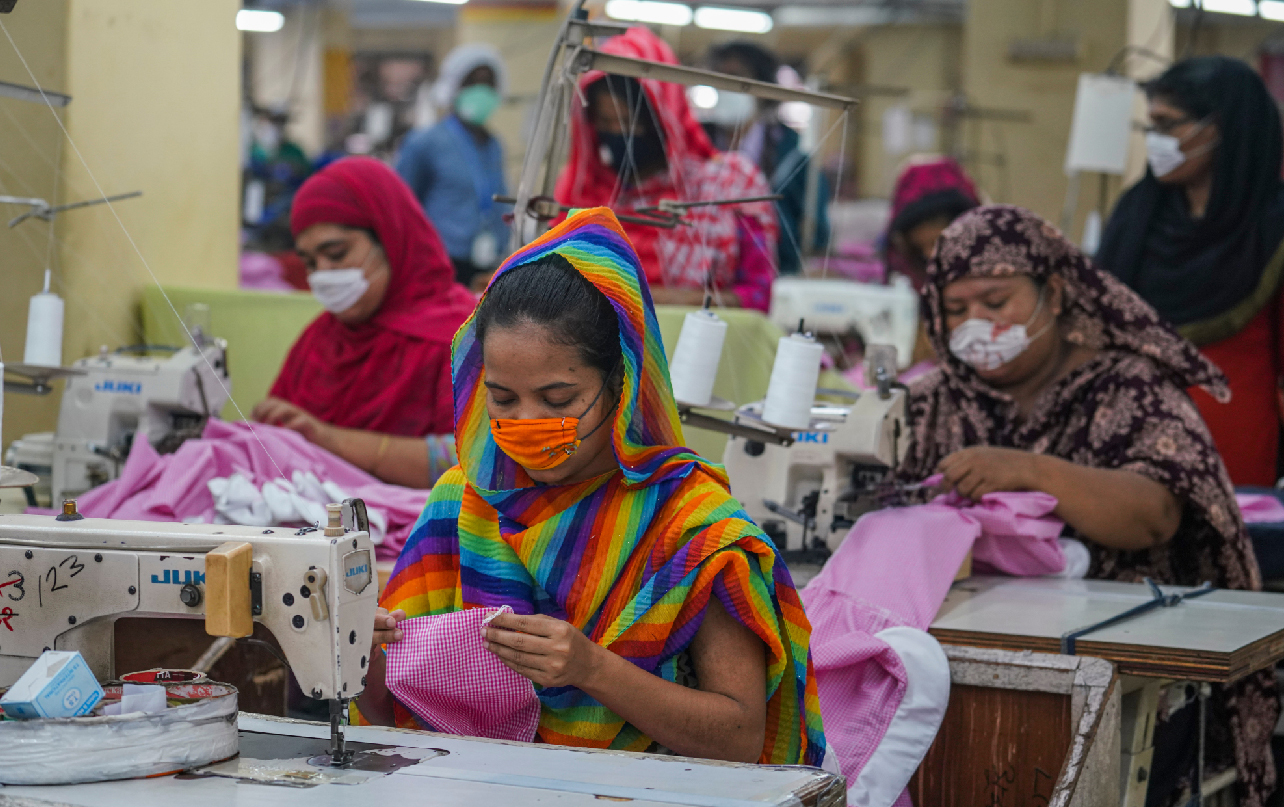During an interview for our Southern Voice-CPD-IPS study on the effects of COVID-19 on the apparel sector, a Bangladeshi Ready-Made-Garments (RMG) worker could not hold back his tears. The pandemic changed his life abruptly. The factory in which he had worked for over three years, suddenly bankrupted. It led to the disruption of his livelihood and forced him to migrate back to his village. His is just one of many similar stories of Bangladeshi RMG workers in 2020.
COVID’s impact
The global apparel value chain went through an unprecedented crisis due to COVID-19. The pandemic, initially a health crisis, eventually turned into one of the most devastating economic catastrophes in decades – including for the global apparel value chain. The forced lockdown across the globe, particularly in significant apparel markets like USA, European Union and Canada, disturbed the apparel value chain’s up-and down-stream. This affected suppliers, employees/workers, raw material suppliers, brands/retailers/buyers, and consumers.
Despite several initiatives by both sourcing and supplying countries’ governments, the fall in global apparel demand (41% and 42% in April and May 2020 respectively, as per ITC Trade Map) had multiple negative consequences in the short run. These include fall in prices, shortage of raw materials, cancellation and deferment of orders and job losses. Between January and July 2020, Bangladesh’s apparel export decreased by almost 23% compared to 2019, while Sri Lanka’s export decreased by nearly 31% between January and August 2020.
With a gradual decrease of the pandemic’s intensity, the apparel industry is expected to start recovering in 2021. However, the medium-term recovery is likely to be more challenging than anticipated. Projections on different global economic indicators suggest that the slump in the worldwide apparel demand could last for months. Moreover, signs of a second wave of the pandemic are already showing. As a result, uncertainty over the future is impeding the revival of the industry in the medium-term. Other challenges include regaining profitable order price and continuing operations amidst the “new normal.”
Current recovery initiatives
Most of the actions undertaken by supplying countries, such as Bangladesh and Sri Lanka, are short-term fiscal and monetary measures. Some examples are subsidised credit support, deferment and waiver of paying different utility charges and tax cuts. Yet, the initiatives targeting medium-term recovery of economic activities, particularly for the apparel sector, are still limited. The scope of robust support for the apparel industry by governments –particularly of the supplier countries–is relatively narrow, given their fiscal constraints, due to the pandemic. On the other hand, a few proposals have been started by fashion brands and their alliances (such as ACT – Action, Collaboration, Transformation). These include commitments regarding maintaining workers’ wages, standing in as an informal ‘guarantor’ on behalf of suppliers for bank loans, and expanding online businesses. Although these initiatives certainly aid the sector, they have a slim level of effectiveness in addressing the medium-term uncertainties, particularly at the suppliers’ end. Therefore, only innovative, inclusive, and pragmatic initiatives can save the industry in the long run. Besides, failure to ensure early and sustainable recovery of the apparel value chain would harm many apparel supplying countries’ ability to achieve major milestones of the UN Sustainable Development Goals (SDGs). The most affected goals would be “SDG 1 (no poverty)”, “SDG 2 (zero hunger)”, “SDG 5 (gender equality)”, “SDG 8 (decent work and economic growth)” and “SDG 9 (industry, innovation, and infrastructure)”.
How to help the apparel sector
Our analysis of the pre-and post-COVID scenario suggests a value chain-based solution is feasible. Adopting a distributive approach in import orders by the brands/buyers among supplying countries would be an essential first step.
Although the pandemic came as a big crisis for all apparel exporting countries and the total amount of orders has decreased, the problem’s extent varies from country to country. In some cases, like in China, the emergency somewhat benefitted countries regarding the market share of total global apparel export. The country had around 35% of the worldwide market share of export of apparels in the pre-COVID period (December 2019). It subsequently increased to almost 42% during the pandemic (June 2020). The market share for a few other developed and developing countries – including Germany, the Netherlands, Italy, Turkey and Vietnam – increased during the crisis as well. However, other countries, including both Bangladesh and Sri Lanka, have seen a decrease in their global market share during COVID times.
Under these circumstances, buyers and brands could consider a distributive approach to ensure maintaining export orders at least pre-COVID level. The principle of order distribution would be keeping the benchmark level of orders of supplying countries at the pre-crisis level along with other public and private sector initiatives. This redistribution would be possible within the product basket countries without compromising the quality and standard of merchandise as per the buyers’ requirements. It is particularly true for countries with limited fiscal capacity, weak social support programmes, and low public borrowing levels during dire times to support suppliers and workers.
The suggested distributive approach could be considered by big buyers from key sourcing countries/regions, like the USA, European Union and Canada. Their governments would have to state this as an official position, encouraging their local brands and buyers to follow a distributive approach in case of apparel import. With such a measure, they could salvage the suppliers and millions of workers of the global apparel value chain.
Text editor: Gabriela Keseberg Dávalos


